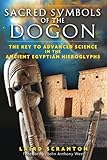|
Editorial Review Product Description
Dogon cosmology provides a new Rosetta stone for reinterpreting Egyptian hieroglyphs
• Provides a new understanding of Egyptian hieroglyphs as scientific symbols based on Dogon cosmological drawings
• Use parallels between Dogon and Egyptian word meanings to identify relationships between Dogon myths and modern science
In The Science of the Dogon, Laird Scranton demonstrated that the cosmological structure described in the myths and drawings of the Dogon runs parallel to modern science--atomic theory, quantum theory, and string theory--their drawings often taking the same form as accurate scientific diagrams that relate to the formation of matter. Scranton also pointed to the close resemblance between the keywords and component elements of Dogon cosmology and those of ancient Egypt, and the implication that ancient cosmology may also be about actual science.
Sacred Symbols of the Dogon uses these parallels as the starting point for a new interpretation of the Egyptian hieroglyphic language. By substituting Dogon cosmological drawings for equivalent glyph-shapes in Egyptian words, a new way of reading and interpreting the Egyptian hieroglyphs emerges. Scranton shows how each hieroglyph constitutes an entire concept, and that their meanings are scientific in nature. Using the Dogon symbols as a “Rosetta stone,” he reveals references within the ancient Egyptian language that define the full range of scientific components of matter: from massless waves to the completed atom, even suggesting direct correlations to a fully realized unified field theory. ... Read more Customer Reviews (4)  Excellent Thesis!
Excellent Thesis!
I have to admit that the string theory is a bit over my head, but Laird Scranton made some excellent observations in this book.I have studied Egyptology and ancient languages for many years, and he put forth explantions for the hieroglyphs I had never even considered, and they have great merit.Based upon Mr. Scranton's reasoning and use of hieroglyphs, I have been prodded to study other words (like about obelisks) to see what deeper meanings they might possibly have, and I haven't been disappointed.
Semitic languages are fascinating, and Egyptian writing is even more so, because of the determinatives used at the ends of the words.This book has opened up a whole new avenue of research for me, and I want to thank Mr. Laird for his contribution to the study of science, language, and ancient history.
 Dogon it!
Dogon it!
Sacred Symbols of the Dogon is essentially an extension of Scranton's previous book "The Science of the Dogon" where the author attempted to show parallels between Dogon mythology/cosmology, and modern theories of the nature of matter and the universe (quantum mechanics, general relativity, string theory). In Sacred Symbols of the Dogon, Scranton looks for similar parallels in the language and symbology of Egyptian hieroglyphs. Readers who lack a familiarity with any of these areas of study may find this book difficult in more than one way. That there are similarities between the languages and symbols of the Dogon and Egyptian's is both interesting, and not really surprising. That they also embody modern concepts of string theory is less convincing. Other concerns with this book:
1. According to Scranton, the primary purpose of the book is to focus on the "prima facie" similarities in Dogon and Egyptian symbols and their root meanings. Scranton does not investigate as to whether there is any historical link between the Dogon and Egyptian cultures and what importance this may have for his findings.
2. Scranton relies almost entirely on Wallis Budge's "Egyptian Hieroglyphic Dictionary" for his interpretations, even though Budge's work is considered outdated by modern Egyptologists.
3. Budge's dictionary often shows mutliple meanings for a single hieroglyph or Egyptian word. Scranton is not bothered by this, and attempts to show that all the various meanings are related.
4. Scranton also relies exclusively on the work of Marcel Griaule and Germaine Dieterlen for his knowledge of the Dogon. According to Griaule/Dieterlen, the Dogon cosmological view has always been a closely guarded secret knowledge held only by the Dogon priest class. Modern Dogon researchers have been unable to confirm this fact.
5. Scranton wants to suggest that the Dogon/Egyptians had an "a priori" knowledge of modern science but never attempts to investigate where they got this knowledge, what they did with it, or how it benefited them. It does not occur to Scranton that modern science may in fact be a product of ancient mythologies and religious beliefs. Take the "Big Bang" and "Black Hole" theories for example.
6. Scranton claims that the Dogon/Egyptian symbols provide evidence that both were aware of string theory. This claim is simply hard to believe for reasons too numerous to go into here. In short, string theory is a relatively new theory that is still a work in progress, and has little support from mainstream scientists. It is a theory based on a magic-like vibrating string that doesnt even exist in our 3D space-time continuum. Consequently, it cannot be proved or verified in practice. Why would the ancient Dogon/Egyptians possess such a theoretical/magical theory that modern science cant even prove?
 Sacred Symbols of the DOGON
Sacred Symbols of the DOGON
I have not yet read the entire book, but did receive it and am eager to get to it, as soon as it is returned (I loaned it immediately to a friend :)
I expect that many in my 'circle' will enjoy and gain from the information.
 Sure to interest any New Age collection
Sure to interest any New Age collection
In THE SCIENCE OF THE DOGON Scranton demonstrated the cosmological structure described in the myths of the Dogon parallels modern science, with illustrations often representing scientific diagrams of today. SACRED SYMBOLS OF THE DOGON continues the exploration for collections interested in early spirituality or Egyptian hieroglyphic language: here the Dogon symbols are revealed in a discussion of ancient Egyptian languages and scientific parallels sure to interest any New Age collection interested in scientific foundations of early Egyptian history.
... Read more
|


